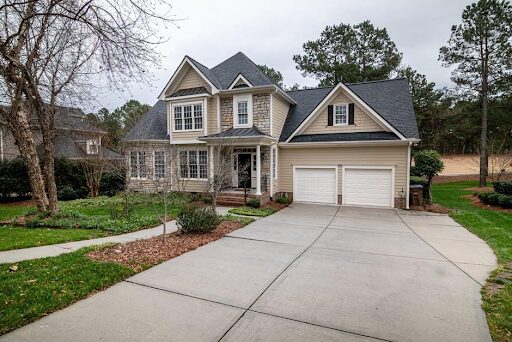If you’ve already observed water puddles on your concrete slab or another concrete surface, you might wonder how to stop them and where the water is coming from. Furthermore, it’s not appealing to have water pooling on a patio or concrete slab. If it is not cleared away quickly, standing water might cause catastrophic damage.
Fixing standing water on a concrete slab is a simple process. If you have ever had a concrete slab in your backyard, you have dealt with standing water. In addition to being unattractive, the water can harm your slab and serve as a mosquito breeding ground. Your property could sustain significant damage due to this severe drainage problem.
Preventive maintenance is the key to removing standing water from a concrete slab. For instance, if you manage an apartment complex, ensure the property has adequate drainage and gutters so that rainfall doesn’t collect around your buildings.
Table of Contents
Identification Of Standing Water On Concrete Slab
Identification of the issue is the first step, just like with every problem you may encounter. For instance, if your gutters are blocked, you should sweep them out and check to see if they are draining correctly. For example, you may construct drains or lengthen the existing ones to catch the water and direct it away from your concrete.
Reasons That Cause Standing Water On Concrete Slabs
It’s good to determine the root of the problem so you can address it. You may take action to address the issue after you understand where the water is coming from and what causes it to collect on your concrete surface.
- Water Or Moisture Left On The Concrete Slab
- Seepage
- Drainage Pipe Blockage
- Concrete Slab Was Installed In A Damp Area
- Moisture Barrier on the Slab
- Faulty Gasket
Fixing Standing Water On A Concrete Slab By Mud Jacking
Act immediately if you have a concrete slab that is beginning to show indications of wear. The slab developing a low point in the center is one issue.
While this might not seem a considerable concern initially, it might cause cracks and additional harm. This works well to fix the damage that has already occurred, but it can also aid in avoiding future issues.
Mud jacking is the most effective technique. By mud jacking, the slab is raised back into position by injecting a slurry of concrete and other materials underneath it. You are now more knowledgeable about dealing with water puddles that frequently form on your concrete slab or driveway.
Additionally, you are aware of the causes of it as well as what can be done to stop it from happening again. Keep the concrete surfaces in your home dry and free of puddles by keeping these things in mind and using all the practical advice.
Steps To Fix Standing Water On A Concrete Slab
- Identify the problem.
- Fix the source of the problem.
- Clean up the area from concrete puddling.
- Applying a concrete sealer
- Replacing concrete
- Raising and leveling of concrete
Simple Fixes For Standing Water On Concrete Slabs
Use Of A squeegee
A squeegee is a long handle with a rubber blade that you move back and forth across the concrete slab. There are numerous sizes and types of rubber blades available.
You can use them to remove extra liquid from your concrete slab or to flatten any standing water. Squeegees are affordable, simple-to-use gadgets available at your neighborhood hardware shop.
Utilizing A Shop Vac For Concrete Slab
You may quickly get rid of standing water off the surface of your concrete slab by using a shop vac. To remove extra water, you must first place the shop-vac hose beneath the slab’s surface and turn it on. Since shop vacs are inexpensive, readily available, and simple, using one can help you save time and money.
Let The Concrete Dry
Allow the water on your concrete slab to evaporate if it is still wet. Before beginning any other work, ensure adequate ventilation surrounds the area where you are drying out your concrete slab.
Your slab can be covered with a tarp or plastic sheeting for the night so it can dry, and the following day the coverings can be taken off. If your garage has a ceiling fan or other means of generating circulation, this will hasten the drying process and swiftly eliminate any standing water.
Making use of a blowtorch
You can get rid of any extra water on your concrete slab using a blow torch. An alternative to using a blow torch is to use a gas weed burner. This technique can also remove rust on metal surfaces in the garage.
Use of a Floor Drain
If your garage has a floor drain, there may be a problem with standing water on the concrete slab. You should immediately hire a plumber to come out and assess the situation if unsure where this drain flows. They will be able to unclog the drain if it is clogged and aid in clearing out any standing water in your garage.
Enhance the drainage system
If you have standing water in your garage, your drainage system may not be functioning correctly. To remedy this issue, speak with a landscaper or other type of service expert to see if they can identify the root of the problem and the best way to fix it.
Conclusion
Preventive maintenance is the key to fixing standing water from a concrete slab. For instance, if you manage an apartment complex, ensure the property has adequate drainage and gutters so that rainfall doesn’t collect around your buildings.
Make sure there are no puddles on any slabs outside homeowners’ residences by frequently inspecting all downspouts and drains and, if necessary, installing a gutter guard. When it rains, it’s also a good idea to have buckets or other waterproof containers close to the door to catch any extra runoff before it may cause harm.





